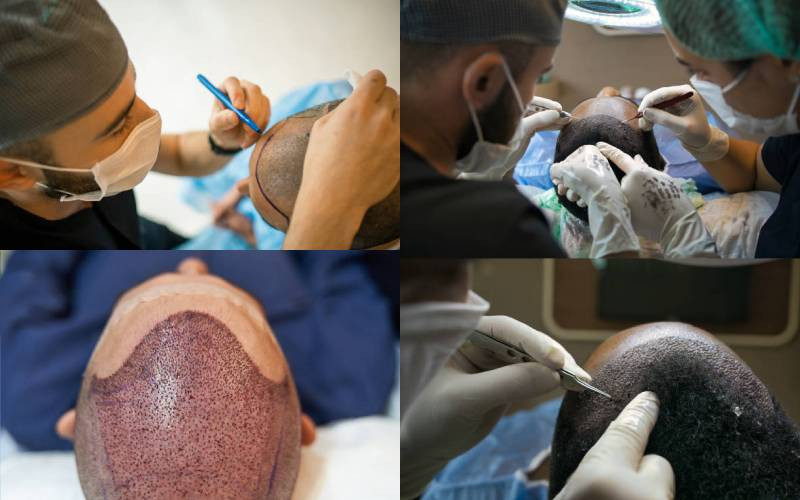
Did you know that your hair grows just like a plant? And that hair can be transplanted from elsewhere on your head to the bald parts right here in Kenya? It can even be transplanted to your eyebrows for fuller eyebrows and if you always wanted to be part of no-shave November but only had a few stragglers on your chin, you can now have a full Viking-style beard if you want to thanks to technology.
Growing up in Githurai 45, Michael Macharia looked like he had a receding hairline, but it wasn’t actually receding, he always just had a hairline that started from further back than most. “It was like that since I was born,” he tells Sunday.
It wasn’t bad enough for him to get bullied or anything but the more he grew up, the more he noticed it. He has always loved music and in high school, inspired by other DJs, he started dreaming of becoming one himself and achieved his dream. But the hairline continued to be a little thorn in his flesh.
“I just felt uncomfortable, I didn’t really feel like myself,” he says. It didn’t help that some friends would sometimes talk about it during friendly banter.
“My friends used to be like, ‘Ei Michael, your hairline starts from far!’ I used to make fun of them too but it kind of used to affect me,” he says.
And yet, he explains that as a DJ you have to look good and be absolutely confident. He was, but not as much as could be, so he started looking for a solution. He first tried a hairline tattoo, not a complete one but only on the sides of his head.
“There are people who do tattoos which look like hair but it didn’t work for me. I love hair so I always wanted to have hair. With the tattoo, you have to shave frequently and always be clean-shaven so that the tattoo doesn’t look different. I wanted something natural,” he says.
So he started researching online, and in the process, he and his cousin found the hair transplant option and the place he could get it down in Kenya. After visiting the clinic and looking at previous work they had done, he saved up and went in for the procedure.
- Returning to work after maternity leave
- Teach your children good values at an early age
- Keeping your children busy over the holidays
- Safely include your children in the kitchen with these tips
Keep Reading
“I was a bit afraid, wondering what would happen to my head, what the outcome would be, would it be painful – but they explained how simple it was, that maybe I’d feel a bit of pain with the first injection but after that, I would be okay,” he says.
He had dreadlocks so they had to be shaved down. Then the doctors did several injections all around his head to numb it, which Michael explains was the only part that was slightly painful. After that, he felt nothing.
“Then they removed hair from the back of my head from the roots and put it in a safe place. After that, they come to the front of the head where they create the holes where they want to plant the hair. They made the channels where the hair would be planted and planted the hair one strand at a time,” he says.
The whole time, he was wondering how long the procedure would take (it lasted about six hours), and how long it would take to see his hair growing.
Immediately after the transplant, he could see the hair, but he says that in the first seven days, it starts withering and you end up clean-shaven again.
“It’s like you have planted a plant in the ground, the way the leaves wither but the roots are left in the channels they created. Then you go back to looking like you don’t have hair, but the roots are still intact,” he says.
Two days after the procedure you go back for a checkup where they wash you with a certain medicine that prevents you from feeling itchy and also give you a certain soap that you use to wash your head so that you don’t scratch it because if you do you will ruin the still-delicate roots.
“They also give you some precautionary measures – for instance, you shouldn’t bend your head down in a certain way for the first seven days. You can’t sleep on your side, you have to sleep facing up. Even when looking at your phone you have to lift it. And you have to be indoors. For those seven days, your head has to be upright all the time to prevent inflammation. After the seven days, it will be fine but you still have to avoid tampering with the hair,” he says.
He explains that after the first seven days, you go for a follow-up and they check how your hair is growing and give you something to keep it growing. You keep going for several check-ups every once in a while to make sure everything is going well.
After the hair withered, Michael started seeing his new hair growing in about a month. During the interview, his hair is at six months of growth and he has even been to the barber several times. He bends down to show me the new hair and unless he tells you that it is transplanted hair or you knew him before, there is no way of knowing that it wasn’t always there. Not even a barber, who has to get up close and personal with the hair, can tell.
Berkay Kargi, a hair transplant specialist at Leader Hair Clinic in Kenya, says that there is a high demand for hair transplant in Kenya. In their clinic, their patients are at a ratio of about 65 per cent men and 35 per cent women. The clinic does hair, eyebrow and beard transplants.
They use several techniques to do it, including the Sapphire, F.U.E (Follicular Unit Extraction), and D.H.I (Direct Hair Implantation) methods. For the front areas where there is no hair at all, they use Sapphire. But in between, maybe someone has spaces in their hair, DHI is used. They can also use the hybrid method where the methods are combined. Also, all the latest hair transplant technologies are available here in Kenya.
“But not everyone who does hair transplants can execute the removal of afro hair because it’s not like Caucasian hair for instance which is straight. Afro hair curls inside, so it’s a different type of skill and specialisation is needed to remove the follicle,” he says.
In addition, not all afro hair works for eyebrow transplant because some of it is very tightly coiled. Hair taken from the head grows the same way it used to on the eyebrows. So before the transplant is done, they have to do a consultation where they have a look at what type of hair it is.
If the transplant is done, the person has to shave the new eyebrow hair regularly, because it can grow to the same length it used to be while it was on your head.
For most people who get it, that is a small price to pay. Michael says it cost him about Sh150,000 to get his done, and he says it is a very fair price for the benefits that he gets.
Berkay says that it restores patients' self-esteem and gives them a lot of confidence and pride. “It really changes their lives. Everyone wears a hat when coming in but when leaving and when they come back for follow-up, they have no hat. Even for me, if I was bald maybe I would be a bit more shy. Maybe I wouldn’t even have done this interview!” he says with a laugh.
That has been Michael’s experience. He had no complications at all and he wishes he had done follow-up.
“I feel great, I think more women want me now but I avoid them! (laughs). I’m looking forward to growing back my locks. By December my hair will have really grown back and I can redo the locks. My confidence is at 100 per cent,” he says.
“In my daily life, I feel free, I feel like I’m a man like I can face anyone. You know sometimes you go to some places and you know you have a certain weakness so you try to hide it. I used to wonder which hat I would wear that day but now I don’t bother with them much,, I’m good to go. It has also improved my career as a DJ because I am much more confident now.”
WHY MORE WOMEN ARE DOING HAIR TRANSPLANT
In a salon, a group of middle-aged women engage in a heated debate on hair. The topic revolves around why people dye hair, why some women wear wigs, why others are going for hair transplant surgery and why others would opt to hide their bald head. It is about men and women middle-aged really want to look old when they have options of keeping beautiful. We know women at advanced age wear wigs because their hair can’t grow anymore while others just want to keep the young looks by keeping their white hair off the public,” one says.
“I wouldn’t mind my man doing a hair transplant if he is suffering hair loss. I mean, doesn’t it affect your self-esteem if you are chilling or on a date with a bald man whose hair is thinning because he is an old guy?” another one says before the rest break into animated laughter.
Research has it that up to 50 per cent of women will suffer hair loss at some point in their lives. 40 per cent of women will suffer visible hair loss by the time they turn 40. Many may look for hair restoration treatments. Men hardly know options for replacing lost hair as much as the per cent. Still, unlike men who commonly experience receding hairlines, per cent experience more thinning across the scalp. For that matter, female hair loss is often stigmatised more than male counterparts.
According to Ziering Madical, an online medical journal, the approach to hair transplants in women differs notably from that in men due to the different patterns of hair loss and aesthetic goals. In the website’s article headlined “Female Hair Transplants: All you need to know” they argue that women typically aim for a subtle enhancement, focusing on increasing density rather than drastically altering the hairline.
Hair transplant has been applied by famous female stars, some of who have often shared their experiences.
American singer Ann Ferguson aka Fergie Duhamel had a hair transplant following her traction alopecia condition worsened. The term is given to hair loss that is triggered by repeatedly pulling on the hair. Her case widened the parting of her hair thus causing a bald spot at the centre of her scalp.
Then there is the famous supermodel Naomi Campbell has had her career demanding that she use hair extensions and other hair styling products. Her hairdo routine eventually led to traction alopecia causing her to suffer from bald patches around the temples and a receding hairline. She eventually had a hair transplant.
We know Oprah Winfrey not only for The Oprah Winfrey Show but also for her fine looks. According to aventusclinic.com, Oprah arranged a hair transplant following constant hairstyling, as well as the frequent use of hair extensions, tongs and other products and tools which damaged the hair over the many years of hosting her show. She is still famous for her thick, glossy and full head of hair, despite being nearly 70 years old.
Tyra Banks is also on this list. She got her hair transplant following alopecia areata, a condition that occurs when the immune system mistakenly attacks the hair follicles in the scalp, causing them to become inflamed, thus preventing them from producing thick and healthy hair.
 The Standard Group Plc is a multi-media organization with investments in media platforms spanning newspaper print
operations, television, radio broadcasting, digital and online services. The Standard Group is recognized as a
leading multi-media house in Kenya with a key influence in matters of national and international interest.
The Standard Group Plc is a multi-media organization with investments in media platforms spanning newspaper print
operations, television, radio broadcasting, digital and online services. The Standard Group is recognized as a
leading multi-media house in Kenya with a key influence in matters of national and international interest.










